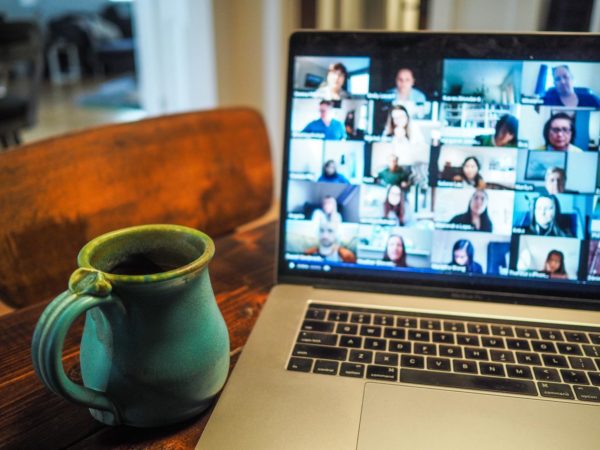
How to Reduce Anxiety when Video Conferences Form an Important Part of Your Day

Video conference calls have become a necessity for those working from home – in fact, meeting apps are not just playing a crucial role in keeping people connected but also in keeping them employed. And if you are looking for a new role, the chances are your interview will be conducted via a video call.
But it is true to say that this new way of working was ‘downloaded’ by the vast majority of the UK with little or no training, and no time to adapt. And – whilst it’s no surprise that video conferencing apps such as Zoom are seeing a staggering growth in users from approximately 10 million daily meeting participants in December 2019, to more than 200 million, in March this year – it’s also little wonder that many are still struggling to navigate their way through so-called conference call “netiquette.”
Other video conferencing platforms have also experienced similar increases. In April, Microsoft Teams reported that its number of daily active users had increased by around 70%, from 44 million to more than 75 million in just one month.
It is not just existing teams and familiar colleagues who are now having to embrace the virtual workplace. Video conferencing platforms have also increased in popularity for businesses and recruiters as they look for safe alternatives to face-to-face introductions and job interviews.
But despite its growing popularity, the thought of participating in video calls with managers and colleagues, and especially potential employers, can leave some people feeling anxious, stressed, exposed and exhausted.
Priory’s Dr Paul McLaren, consultant psychiatrist at the Priory’s Wellbeing Centres across London, and Medical Director of the Priory Hospital, Hayes Groves near Bromley in south-east London, works with many people currently using video conferencing.
He says: “A lot of the anxiety comes from the novelty. Video conferencing is new to many people, and for the older generation, tech can still be intimidating. However, for the younger generation sitting on a video call is more their natural habit. If you are concerned about a video-call-cum-interview, think of it this way: it may actually be less scary than having to sit opposite a panel of senior directors and HR execs in a strange and imposing office.
“So yes, there may be a generation gap on some levels but there are common themes currently causing anxiety across the board, including unfamiliarity with the specific platforms your employer or client is asking you to use, a fear of embarrassing yourself in front of a row of ‘close-up faces’, the pressure of unreliable internet connections, and the thought of having to look at yourself throughout a meeting.”
To help avoid and alleviate conference call anxiety, Dr McLaren offers 10 tips:
1) If you are anxious about video conference calls, always try to ask someone who is more familiar with the technology to talk you through it first – that could be your tech savvy son or daughter. Set up a background you like and make sure you are making the call from somewhere you feel comfortable, and that it is as sound-proof as possible. Microsoft Teams and Zoom enable users to blur their backgrounds if your room is a bit chaotic, and Zoom supports custom-made backgrounds for high-end computers.
2) It is important you are not inhibited by fearing you will be overheard. Use earphones if possible. Take time to set up. The more comfortable and confident you feel, the less anxious you will be. And always acquaint yourself with the mute button. Extraneous and unexpected noise is much more likely at home than in the office so mute your microphone when you are not speaking to avoid embarrassing attention shifts.
3) If you are anxious about using video conferencing for formal tasks, remember that social interactions are all about power and hierarchies. You are on your own ‘turf’ rather than going to, say, your manager’s office. To reinforce that point, you could make it as comfortable for yourself as possible.
4) Have a back-up plan arranged with the other person. For example, if they are leading on a job interview, you would hope that their digital kit and communications will be reliable and up for the task. If you are worried about your line dropping, or the bandwidth being drained by a video game, do what you can to check and reduce the risk. But it’s also worth putting it out there at the start. Video conferencing is such a novel way of doing things, it’s okay to say, “What should I do if my line drops?” They should offer you a number to call or say that they will call you within a specified period of time. This avoids frustrating and anxiety-provoking phone calls ‘missing’ each other.
5) If you think about what would happen in a live meeting – you would usually look at the speaker, look around the room when you are speaking and scan the room at intervals. That is not done naturally with video-conferencing, therefore it is worth developing a kind of technique for doing so that still makes you look comfortable.
6) Some people are anxious about video conferencing primarily because of their own issues. They have problems with body image and feel very comfortable on a telephone call, but appearing on screen may be difficult for them. It is difficult for the other person to pick up the cues that show we are anxious. Getting just a ‘head and shoulders’ shot misses the non-verbal signs in our posture such as moving our hands or feet. A would-be employer might detect anxiety in your voice, but if you are really anxious and self-conscious, then it is perfectly okay to let them know.
7) If you do have self-image issues, then once you get yourself positioned in shot, switch off your self-view. You do not need that distraction.
8) If you are interviewing by video conferencing and want to minimise the impact of the medium on your task – which is getting the right person for your role – remember that some people may find the medium anxiety-provoking. Check that they are comfortable and ask them how they feel about being interviewed that way. And try to remember that while many face-to-face meetings take too long, video conferences are no exception. Research shows that the average mind wanders after 18 minutes, so keep things to the point
9) You might want to consider how you sound, including your distance from the microphone. Switching from a laptop’s built-in microphone to a headphone microphone can help. You might want to record yourself on a call in advance and listen back so you can hear how you sound. If you were sharing a room with someone, you might modulate the sound of your voice, so you may want to experiment with that
10) Sometimes seeing the person you are speaking to does not enhance the experience. Phone calls can be just as useful and can make both parties more relaxed, so don’t think that because video conferencing is there, you have to use it.













































